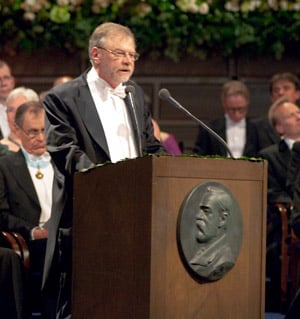Award ceremony speech
English
Swedish
Presentation Speech by Professor Måns Ehrenberg, Member of the Royal Swedish Academy of Sciences; Member of the Nobel Committee for Chemistry, 10 December 2009
 |
| Professor Måns Ehrenberg delivering the Presentation Speech for the 2009 Nobel Prize in Chemistry at the Stockholm Concert Hall. Copyright © The Nobel Foundation 2009 Photo: Hans Mehlin |
Your Majesties, Your Royal Highnesses, Ladies and Gentlemen,
This year’s Chemistry Prize rewards crystallographic determination of ribosome structures at a resolution so high that the positions of single atoms can be estimated and the use of these structures for atomic level clarification of how the ribosome links amino acids to proteins according to the blueprints of the genetic code and of the working principles of antibiotics attacking the ribosomes of bacterial pathogens.
All life on Planet Earth depends on the existence of proteins. Proteins speed up the life-essential chemical reactions in the human body, control them and make it possible for us to see, hear, taste, smell, feel, experience, think and move. Proteins make us less sensitive to pathogen attacks and make it possible for us to meet here today in celebration of this year’s Laureates. The story of how proteins are made between the two large subunits of the ribosome, consisting of long RNA chains and about fifty proteins, is therefore a tale of the existential basis of our civilisation.
In the well-ordered chaos of our genome there are thousands of DNA-based genes encoding all the different types of proteins in the human body. These blueprints for proteins in the genome are continuously copied to messenger RNAs, one for each protein. When a messenger RNA has found a ribosome, it is anchored between the ribosomal subunits, ready to be translated to the chain of amino acids which, properly folded, becomes active protein. Each one of the twenty types of amino acids enters the ribosome linked to its own class of transfer RNA molecules. On the ribosome, these transfer RNA molecules recognize the code words in messenger RNA for their own amino acid and, thus, the ribosome factory links the amino acids together in the sequences prescribed by the blueprints for proteins.
Ada Yonath’s pioneering work during the 1980s laid the foundation for determination of high-resolution ribosomal structures with crystallographic techniques.
In 1998 Thomas Steitz solved the so called phase problem for the large ribosomal subunit and could thereby determine the first ribosomal crystal structure.
In the year 2000, all three Laureates presented high resolution structures of ribosomal subunits, Steitz of the large, Ramakrishnan and Yonath of the small ribosomal subunit.
Thomas Steitz’s high resolution structures of the large ribosomal subunit in functional complexes led to atomic level understanding of how formation of peptide bonds between amino acids is catalysed on the ribosome.
Venkatraman Ramakrishnan’s crystal structures of the small ribosomal subunit in functional complexes led to atomic level understanding of how ribosome-assisted reading of the genetic code can be so accurate that virtually all proteins are made error free in accordance with the blueprints of their genes.
Ramakrishnan, Steitz and Yonath determined high resolution structures of ribosomal subunits in complex with antibiotic drugs, leading to atomic level understanding of how these drugs inhibit ribosome function and how drug target resistance may evolve. This essential knowledge is already used in the development of novel antibiotic drugs in the on-going medical struggle against the ever emerging drug resistance among bacterial pathogens.
Professors Ramakrishnan, Steitz and Yonath,
You are being awarded the Nobel Prize in Chemistry for the crystallographic determination of ribosome structures at high resolution and for the skilful use of these structures to clarify fundamental and medically important aspects of ribosome function.
On behalf of the Royal Swedish Academy of Sciences, I wish to convey to you our warmest congratulations and I now ask you to step forward to receive your Nobel Prizes from the hands of His Majesty the King.
Nobel Prizes and laureates
Six prizes were awarded for achievements that have conferred the greatest benefit to humankind. The 12 laureates' work and discoveries range from proteins' structures and machine learning to fighting for a world free of nuclear weapons.
See them all presented here.
